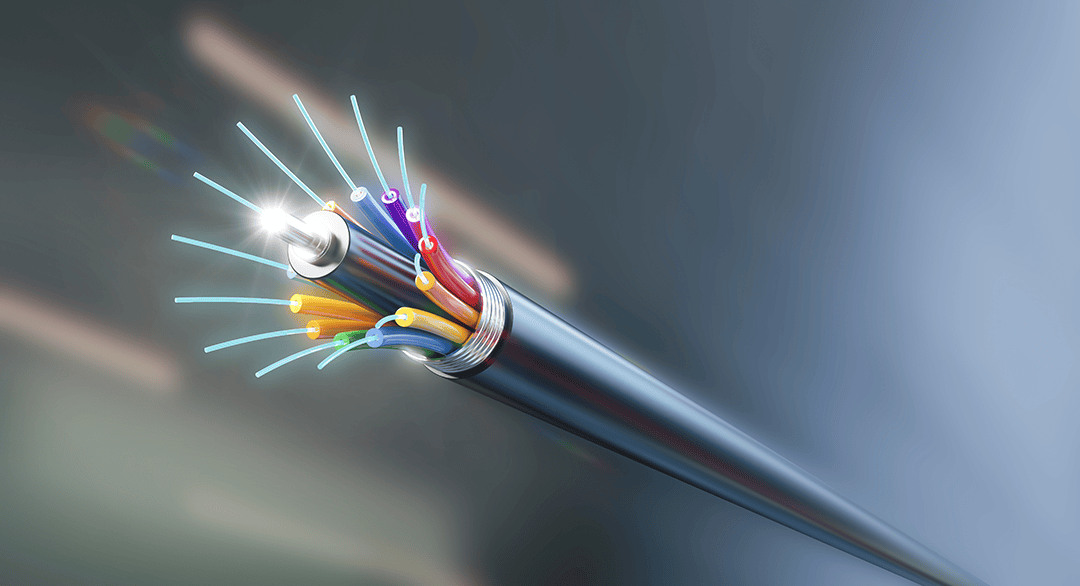What is a passive optical network (PON)?
We explain PONs, how they work, their main types, and their advantages over active Ethernet networks.
- Neos Networks
- Optical , Product interest ,

Get ultrafast, low latency Optical Wavelengths
Supercharge your network up to 400Gbps
What’s a passive optical network (PON)?
A passive optical network (PON) is a fibre optic network that uses passive (unpowered) optical splitters to deliver connectivity from a single fibre source to multiple end users.
They’re called “passive” because they don’t require any electrical power to distribute the signal once it’s sent across the network. As PONs can efficiently serve multiple users from a single fibre, internet service providers (ISPs) typically use them to deploy fibre to the premises (FTTP), also known as fibre to the home (FTTH).
What’s the difference between an active and a passive optical network?
The key difference between active optical networks (AON) and passive optical networks is how they split the signal for each end user. AON use multiple fibres and electrically powered switching equipment to distribute the signal to multiple end users.
By contrast, passive optical networks use a single fibre and an unpowered (passive) splitter to serve different customers. With PONs, electrical power is only required at the send and receive points of the network, making them more efficient than active networks.
How does a PON work?
A passive optical network transfers data, voice and video using light signals transmitted through fibre optic cables.
In simplified terms, a passive optical network consists of the following basic components:
- Optical line terminal (OLT) at the provider’s central office or point of presence (PoP)
- Passive (unpowered) optical splitters, which split the signal and distribute it to multiple output fibres
- Optical network terminals (ONTs), also known as optical network units (ONUs), which relay the signal to points near the end user

Passive optical network
A single fibre optic is run to a passive optical splitter from the OLT at the provider’s central office or PoP. The splitter replicates and divides the light signal, relaying it to many ONTs near end users. Typically, the signal is split between 32 ONTs, although the latest PON standards support 64 or more.
The ONTs then provide the signal to end users. Depending on where the PON ends, this can be:
- Fibre to the premises (FTTP): The fibre connection runs all the way to a customer’s home or business.
- Fibre to the building (FTTB): The fibre cabling runs to the building, for example, serving an apartment block, school or office block.
- Fibre to the cabinet (FTTC): The fire cabling runs to a curbside cabinet, where it’s distributed to individual homes and businesses via copper wires.
- Fibre to the neighbourhood (FTTN): The fibre may end a few miles from the customer’s premises.
Since a PON uses a single fibre, it typically uses wavelength-division multiplexing to split the light signal into upstream and downstream channels. Downstream, the signal is visible to all ONTs. However, each ONT only reads the data addressed to it, and encryption is used to stop eavesdropping on adjacent channels.
Upstream, the wavelength is typically divided by time-division multiplexing, meaning each ONT takes turns transmitting with time slots assigned by the OLT.
With the fibre signal powered only by the OLT, the latest PONs can cover distances of 20-40 km (12-24 miles) between the OLT and the end user.
What are the advantages of passive optical networks?
The passive nature of PONs gives them several advantages over active optical networks:
- Lower costs: PONs are simpler, with fewer components, unpowered splitters and fewer fibre cables, so they tend to cost less to deploy and maintain.
- Energy efficiency: PONs are more energy efficient than active networks because they don’t require power to run and cool active components.
- Reliability: As PONs use fewer passive optical components, which are less prone to failure than powered switching equipment, PONs tend to be more reliable.
- Scalability: PONs are easy to scale by adding more optical network terminals (ONTs), while active networks are more likely to require infrastructure upgrades as they expand.
Types of passive optical networks
Originally developed in the 1990s, the first passive optical networks used Asynchronous Transfer Mode (ATM) to distribute the light signal. APON (ATM PON), which quickly evolved into BPON (Broadband PON), typically delivers data transfer speeds of up to 622Mbps downstream and 155Mbps downstream.
Over the last two decades, GPON and EPON emerged as the main PON standards, although these are fast being superseded by next-generation standards.
GPON
First ratified by the ITU-T in 2003, Gigabit PON (GPON) uses a mixture of ATM and ethernet technology protocols and typically provides speeds of 2.5Gbps downstream and 1.25Mbps upstream. GPON is currently one of the most widely deployed PON standards.
EPON
An alternative protocol ratified by the IEEE in 2004, Ethernet PON (EPON) uses ethernet as its transport protocol and typically provides the same upstream and downstream speeds -- up to 1.25Gbps. Network providers sometimes choose EPON because it works seamlessly with ethernet-based networks and services.
Later-generation PON standards, like XGS-PON and 10G-EPON, can deliver speeds of 10Gbps, while next-generation protocols, like NG-PON2, are set to achieve speeds of up to 40Gbps or more.
Deploying passive optical networks
As UK businesses look to invest in digital transformation, internet service providers are using passive optical networks to give businesses the high-capacity, gigabit-enabled networks they need.
At Neos Networks, we’re helping businesses build their digital future across the UK. To find out more about options for deploying optical connectivity, get in touch.
Get ultrafast, low latency Optical Wavelengths
Supercharge your network up to 400Gbps
Passive optical network FAQs
-
Why are passive optical networks called “passive”?
“Passive” means that a PON requires no power or active electronic parts once the light signal is transmitted across the network. A PON relies on passive optical splitters to distribute the signal to end users. By contrast, active optical networks (AONs) rely on powered (active) components like switches or amplifiers to operate.
-
What are the advantages of PONs over traditional copper-based networks?
Compared to traditional copper-based networks, like Digital Subscriber Line (DSL), PONs offer higher bandwidth and data transfer speeds and lower latency. They can also transmit data over much longer distances without signal degradation. Unlike DSL cables, PON fibre optic cables are immune to electrical interference, and their passive nature means they’re generally more reliable than traditional DSL networks. As PONs can handle higher bandwidths, they’re also easier to scale for future technologies without upgrading infrastructure.
-
What are the main disadvantages of PONs?
PONs require laying fibre optic cables and setting up an optical distribution network, so initial installation costs can be high. In addition, with PONs, a single optical line transmitter (OLT) serves multiple optical network units, so the failure of a central OLT can impact many end users.
-
Is a PON the same as FTTP?
FTTP (fibre to the premises), also known as fibre to the home (FTTH), is a broad term comprising various technologies to deploy fibre optic connectivity to homes and businesses. PON is one optical networking technology that is commonly used for FTTP.
You might also like

Discover our network reach
We can connect you anywhere in the UK
Great news!
"[poscode]" can be reached with our
expanded network
Speak to a representatitive to discuss your options
Contact usLearn about our prices using our online tool, LIVEQUOTE
View LIVEQUOTESorry
"[poscode]" can not be reached with our
expanded network
Speak to a representatitive to discuss your options
Contact usLearn about our prices using our online tool, LIVEQUOTE
View LIVEQUOTE



